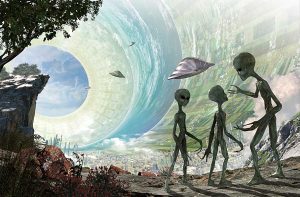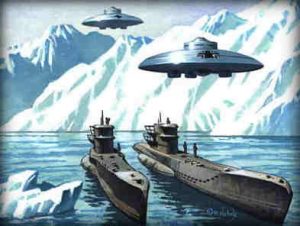This blog post is part of the Frozen Friday Series, an A-Z journey of the Polar Archives. Each week, we will feature some aspect of the history of polar exploration with a blog post written by our student authors
Here at the Polar Archives, our job is to preserve and make available to the public all materials in our collections. Every day we receive reference requests from individuals seeking to study items held in the archives and we gladly help them in any way we can. Sometimes patrons are seeking out information regarding a relative, hoping to prove that a family legend was true. Alternatively, maybe a patron is doing research on one of Admiral Byrd’s expeditions for a class assignment and needs to read one of his journals. Or perhaps a documentary producer or author visits to conduct research on a film or book project.

Hollow Earth believers claim that at
either pole is a massive hole that
leads to the Hollow Earth. Many
claim that explorers such as Admiral
Richard E. Byrd have flown into one of
these holes, though the Papers of
Admiral Byrd hold no evidence
supporting that claim.
We are also happy to answer questions that might not require any in-depth research, or any questions about the general content of the Byrd Polar and Climate Research Center Archival Program. “Where should I look to find any information on my great-grandfather’s role in a Cook expedition” is a question we might get. These are just a few of the possible scenarios.
However, sometimes we get requests that are a little more unorthodox. While we of course treat every request with the respect and service owed, some requests are objectively unusual. Although no items in our collections are classified, we have had the Freedom of Information Act unnecessarily referenced several times. Though some items within our collections were at some point classified, all have since been declassified for some time. Some requests specifically mention subjects that are not a part of mainstream dialogue, such as alien life or underground civilizations. These kinds of subjects usually are tied to one of two questionable theories that commonly come up at the Polar Archives: The Hollow Earth theory and the Flat Earth theory. I have endeavored to learn what I can about these alternative theories and give a basic rundown of their essential tenets.

One brand of Hollow Earth theory believes that at
the center of the Earth is an inner sun that provides
heat and light for the world inside the Earth.
Many cultures have had a Hollow Earth-like globe featured in their mythology, but modern Hollow Earth beliefs seem to date back to John Cleves Symmes, Jr. in the early nineteenth century. The Hollow Earth theory has evolved over time and is now as varied as its devotees, but the universal, core belief of Hollow Earth theorists is that the Earth is hollow. The crust of the Earth is the outer shell and embedded in this crust some miles below us is the ‘center of gravity’, where gravity is reversed. Above that line, objects are pulled towards the center of the planet. Below that line, objects are pulled away from the center. Below the planetary wall exists a completely new world complete with its own continents and central sun. Inhabiting this allegedly lush and warm world is anything from large, thin Grey Aliens, ancient cultures such as the Vikings of Greenland, to Nazis fleeing Allied forces after the Second World War. Some theorists tie this theory to religion, claiming that the mythical Garden of Eden lies beneath us and Adam and Eve were banished from below to the surface. The Lost Tribe of Israel is claimed to have migrated into the subterranean Earth. Hollow Earth theorists believe that the Polar Regions can provide the proof that will convince the rest of the world of their theory. At each of the poles lies entrances into the hollow Earth. Some claim that these entrances are gaping holes that extend miles while others believe that caverns exist that lead to the underworld.

Some Hollow Earth theorists maintain that
advanced cultures live in the Hollow Earth, such as
the notorious Greys, an alien species that is claimed
to frequent the Earth.
Hollow Earth theorists claim that proof exists in numerous fantastical ‘accounts’ of surface dwellers reaching the inside. A common claim is that our own Admiral Richard E. Byrd flew into the Hollow Earth on his famous (or infamous) flight to the North Pole. Another claim, which I came upon while researching for the earlier Operation Highjump Frozen Fridays post, portrays the expedition as an American invasion of Antarctica which failed after encountering heavy resistance from flying saucers.

Some believe that our own Admiral Richard E. Byrd
was forced to retreat from Antarctica by saucers
coming from the Hollow Earth during Operation
Highjump (1946-47).
The other common theory, the Flat Earth, has a bit more uniformity to it. The Flat Earth Society, along with other similar societies, works toward the goal of ‘enlightening’ humanity away from the “Round Earth Conspiracy”. This “Planar Conspiracy” appears to be motivated by the desire to gain power and wealth by siphoning money from space budgets. Flat Earth theorists maintain that the world is flat. The North Pole sits at the center of the map, with the continents and oceans surrounding it. Circumnavigation is thus possible by simply sailing in a circle around the pole. While the North Pole sits at the center, the Antarctic encircles the world, creating a massive ice wall that extends for hundreds of miles beyond the ocean. Believing that the moon landing and photographs are fake, Flat Earth theorists claim that astronauts simply lie about their experiences. Gravity is declared to be false and the claim put forth that objects simply fall. What scientists refer to as the atmosphere is believed to be a dome of air that separates us from the outside. This ‘Dome’, ‘Firmament’, or ‘Vault of Heaven’ is filled with holes that appear to us as stars.

In Flat Earth theory, the Earth has the North Pole at
its center with the rest of the map radiating from it.
The Antarctic lines the world with what is known as
the ‘Ice Wall’ that is very large and extends for
hundreds of miles beyond the points at which it
meets the world’s oceans.
I reached out to the Byrd Polar and Climate Research Center for a response from individuals who have devoted their careers to the study of science. I received the following response from Jason Cervenec, Education and Outreach Director at the B.P.C.R.C., edited for the sake of brevity:
While “questionable theories” have been proposed in the past and will continue to be suggested in the future, science by its very nature has a way of eventually discarding or refining these theories. Some questionable theories first seem quite plausible, such as the Earth being flat …until overwhelming evidence… is discovered… In science, claims must be refutable and based on observations in the natural world. These two underlying components have been around since at least the time of Sir Francis Bacon in the 1500s and 1600s. Likewise, accepted claims in science are ultimately determined by consensus of peers, in other words, the experts who work in a particular scientific discipline. This process plays out today when scientists create posters and talks for conferences that ultimately result in conversations, with manuscripts eventually getting submitted to peer-reviewed journals. Publication is part of the process of acceptance of a claim in the scientific community… This reaching of consensus by experts is very different than our egalitarian views in the United States where everyone’s ideas receive equal treatment and validity. In science, experts determine the accepted claims, often referred to as facts outside of the scientific community, in the discipline where they work.
Questionable theories, such as the Earth being hollow, have been around for a few centuries but have no basis in evidence. In fact, they are easily refuted by satellite data in addition to accounts of the many people, including many researchers from Ohio State, who have travelled to both the Arctic and Antarctic. Nonetheless, these theories persist, often with associated conspiracy theories that the photographic evidence is fraudulent and the military will not allow individuals to visit Antarctica. Similar to witch hunts in Salem, these claims are not based in evidence and often promulgated by individuals who openly state that they are irrefutable. Therefore, these claims are inherently unscientific. While this does not appeal to our sense of egalitarianism of ideas in everyday life, science relies on evidence, prior research, and the wisdom of experts.
Science as a process strives to rigorously weed out ill-formed theories, such as the Flat Earth and Hollow Earth theories. In addition to the centuries of evidence mounted against these questionable theories, no supporting evidence has yet been found in the collections of the Polar Archives. But you don’t have to take our word for it; our collections are open to public research and study, and we encourage researchers to come to their own conclusions! If you’d like to make an appointment to use the collections of the polar archives contact us!
Written by John Hooton.



Recent Comments